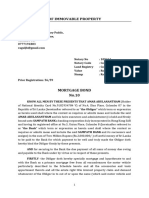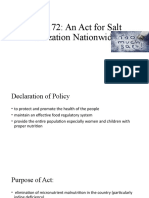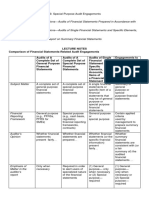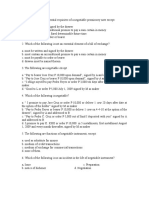Problem 1
Uploaded by
Bae RonaProblem 1
Uploaded by
Bae RonaProblem 1
A company has Division 1 that manufactures and sells its product
as follows:
Capacity in units 100,000
Selling price to outside customers P30
Variable costs per unit P16
Fixed cost per unit (based on capacity) P9
The company has Division 2 that could use Division 1's product in its
production. Division 2 is currently purchasing 10,000 units of
Division 1’s product per year from an overseas supplier at a cost of
P29 per unit.
1. If Division 1 has ample idle capacity to handle Division 2's needs,
what is the acceptable range, if any, for the transfer price between
the two divisions?
Maximum transfer price for buyer is 29 per unit.
Minimum transfer price for seller is 16 per unit.
16 ≤ TP ≤ 29
2. If Division 1 is selling all the units that it can produce to outside
customers, what is the acceptable range, if any, for the
transfer price between the two divisions?
Maximum transfer price for buyer is 29 per unit.
Minimum transfer price for seller is 30 per unit.
[16+(30-16)×10,000/10,000]
3. If Division 1 is selling all of the units that it can produce to outside
customers and that P3 in variable costs can be avoided on transfers
within the company due to reduced selling costs, what is the
acceptable range, if any, for the transfer price between the two
divisions?
Maximum transfer price for buyer is 29 per unit.
Minimum transfer price for seller is 27 per unit.
[(16-3)+(30-16)×10,000/10,000]
Problem 2
A company’s Division S produces a product with cost data as follows:
Selling price per unit on the outside market P40
Variable costs per unit P21
Fixed costs per unit (based on capacity) P9
Capacity in units 60,000
The company’s Division B would begin buying this product of Division S.
Division B is currently purchasing 20,000 units each year from outside at a
cost of P38 per unit.
4. If Division S is currently selling 40,000 units each year to outside market,
what is Division 1’s minimum transfer price?
The Minimum transfer price is 40 per unit.
[21+(40+21)×40,000/40,000)
5. If Division S is currently selling 40,000 units each year to outside market,
what is Division 2’s maximum transfer price?
The maximum transfer price is 38 per unit.
6. With reference to #s 4 & 5, and if left free to negotiate, would each
manager reach an agreement to a transfer price? If yes, what is the
acceptable range for the transfer to take place?
Yes, the acceptable range for the transfer to take place is 31: TP: 38 per
unit.
7. If Division S is currently selling all units it can produce each year to
outside market, what is Division 1’s minimum transfer price?
The Minimum transfer price is 21 per unit.
8. If Division S is currently selling all units it can produce each year to
outside market, what is Division 2’s maximum transfer price?
The maximum transfer price is 38 per unit.
9. With reference to #s 7 & 8, and if left free to negotiate, would each
manager reach an agreement to a transfer price? Why?
Yes, assuming that the managers understand their own businesses and
they are cooperative.
10. With reference to #s 7 & 8, and from the standpoint of the company as a
whole, should a transfer take place? Why/not?
Yes, because the cost of the product transferred is only 21 per unit and
the company saves the 38 per unit cost of the product purchased from the
outside market.
Problem 3
A company has two producing centers, A and B. Department A has a
variable cost of P12 per unit for its products, and a total fixed cost of
P120,000. Department A also has idle capacity for up to 50,000 units per
month. Department B would like to purchase 20,000 units of Department
A’s products per month, but is unable to convince Department A to transfer
units to B at P16. Department A has consistently argued that the market
price of P20 is nonnegotiable.
11. What is A’s opportunity cost of transferring to B as opposed to selling to
outsiders?
0
12. If you were Department A’s manager, would you agree to transfer to
Department B at P16? Why/not?
Yes,
Problem 4
A company presented the following information for its 2 departments in
the past month. Department A is the manufacturing department, whereas,
B is distribution.
Production level of A significantly below capacity
Sales price to B P50 per unit
A’s variable cost P20 per unit
Total fixed cost P120,000
B’s marketing cost 10% of selling price
B’s selling price Market value
13. What’s the minimum transfer price of A to B?
The minimum transfer price of A to B is 20 per unit
14. What’s B’s minimum selling price on A’s products?
The minimum selling price on A's products is 55 per unit.
[(50×0.10)+50]
You might also like
- RA 8172: An Act For Salt Iodization Nationwide100% (1)RA 8172: An Act For Salt Iodization Nationwide12 pages
- Acctg205 TransferPricing-SampleQuestions PDFNo ratings yetAcctg205 TransferPricing-SampleQuestions PDF2 pages
- CPAR Intro To Income Tax and Tax On Individuals (Batch 89) - HandoutNo ratings yetCPAR Intro To Income Tax and Tax On Individuals (Batch 89) - Handout29 pages
- Decentralized Performance Evaluation: Answers To QuestionsNo ratings yetDecentralized Performance Evaluation: Answers To Questions43 pages
- Colegio de San Juan de Letran: Course Module On: ACC119: Principles and Methods of TeachingNo ratings yetColegio de San Juan de Letran: Course Module On: ACC119: Principles and Methods of Teaching62 pages
- Test-Bank-Accounting-Management-11e-Chapter-14-Cost-Allocation-Customer-Profitability-Analysis-And-Sales-Variance-Anaylsis (No ratings yetTest-Bank-Accounting-Management-11e-Chapter-14-Cost-Allocation-Customer-Profitability-Analysis-And-Sales-Variance-Anaylsis (17 pages
- SG Chapter 5 Valuation Concepts and MethodologiesNo ratings yetSG Chapter 5 Valuation Concepts and Methodologies11 pages
- Cost Concept, Terminologies and BehaviorNo ratings yetCost Concept, Terminologies and Behavior8 pages
- Pre-Quali - 2016 - Financial - Acctg. - Level - 1 - Answers - Docx Filename UTF-8''Pre-quali 2016 Financial Acctg. (Level 1) - AnswersNo ratings yetPre-Quali - 2016 - Financial - Acctg. - Level - 1 - Answers - Docx Filename UTF-8''Pre-quali 2016 Financial Acctg. (Level 1) - Answers10 pages
- MS Preweek - Problems (B45) - No AnswerNo ratings yetMS Preweek - Problems (B45) - No Answer10 pages
- Chapter 12 Home Branch Accounting - General ProceduresNo ratings yetChapter 12 Home Branch Accounting - General Procedures4 pages
- AFAR-11 (Consolidated FS - Intercompany Sales of Fixed Assets)No ratings yetAFAR-11 (Consolidated FS - Intercompany Sales of Fixed Assets)7 pages
- 01 - FAR - MODULE 3 - Investments - Agriculture - Borrowing CostNo ratings yet01 - FAR - MODULE 3 - Investments - Agriculture - Borrowing Cost10 pages
- BLT Quizzer (Unknown) - Law On Negotiable InstrumentsNo ratings yetBLT Quizzer (Unknown) - Law On Negotiable Instruments7 pages
- Constitutional and Administrative Law: Unit-2No ratings yetConstitutional and Administrative Law: Unit-244 pages
- Treasury Decisions Under Internal RevenuNo ratings yetTreasury Decisions Under Internal Revenu309 pages
- 01-Invoice 23 OCT 12-Puri Sari Beach HotelNo ratings yet01-Invoice 23 OCT 12-Puri Sari Beach Hotel1 page
- Example Roles and Responsibilities MatrixNo ratings yetExample Roles and Responsibilities Matrix1 page
- Herman Hidayat (Auth.) - Forest Resources Management in Indonesia (1968-2004) - A Political Ecology Approach-Springer Singapore (2016)No ratings yetHerman Hidayat (Auth.) - Forest Resources Management in Indonesia (1968-2004) - A Political Ecology Approach-Springer Singapore (2016)359 pages
- Apendo-Aee-151223 Do You Success Telegram ChannelNo ratings yetApendo-Aee-151223 Do You Success Telegram Channel5 pages
- TIMELINE: ABS-CBN Franchise: Cover StoryNo ratings yetTIMELINE: ABS-CBN Franchise: Cover Story6 pages
- 114 (1) (Return of Income Filed Voluntarily For Complete Year) - 2019No ratings yet114 (1) (Return of Income Filed Voluntarily For Complete Year) - 20194 pages
- Land Development and Planning Laws in Nigeria: The Historical AccountNo ratings yetLand Development and Planning Laws in Nigeria: The Historical Account8 pages
- Chuẩn Bị Cho Kì Thi Tốt Nghiệp Thpt Quốc Gia: A B C D A B C DNo ratings yetChuẩn Bị Cho Kì Thi Tốt Nghiệp Thpt Quốc Gia: A B C D A B C D11 pages
- 2023 - Laporan Tahunan Dan Laporan Keberlanjutan 240531 083956No ratings yet2023 - Laporan Tahunan Dan Laporan Keberlanjutan 240531 083956338 pages
- Instant Download Crime Control as Industry 3rd edition Edition Christie PDF All Chapters100% (3)Instant Download Crime Control as Industry 3rd edition Edition Christie PDF All Chapters71 pages
- Omnibus-Certification - SPED, KINDER, ELEM, JHSNo ratings yetOmnibus-Certification - SPED, KINDER, ELEM, JHS1 page
- Clark County Trustee Auction_May 9 2024_pcl list 040924No ratings yetClark County Trustee Auction_May 9 2024_pcl list 0409244 pages
- Fishbone Diagram + Worksheet: DisclaimerNo ratings yetFishbone Diagram + Worksheet: Disclaimer5 pages
- M.C. Mehta and Anr Vs Union of India & OrsNo ratings yetM.C. Mehta and Anr Vs Union of India & Ors5 pages
- CPAR Intro To Income Tax and Tax On Individuals (Batch 89) - HandoutCPAR Intro To Income Tax and Tax On Individuals (Batch 89) - Handout
- Decentralized Performance Evaluation: Answers To QuestionsDecentralized Performance Evaluation: Answers To Questions
- Colegio de San Juan de Letran: Course Module On: ACC119: Principles and Methods of TeachingColegio de San Juan de Letran: Course Module On: ACC119: Principles and Methods of Teaching
- Test-Bank-Accounting-Management-11e-Chapter-14-Cost-Allocation-Customer-Profitability-Analysis-And-Sales-Variance-Anaylsis (Test-Bank-Accounting-Management-11e-Chapter-14-Cost-Allocation-Customer-Profitability-Analysis-And-Sales-Variance-Anaylsis (
- Pre-Quali - 2016 - Financial - Acctg. - Level - 1 - Answers - Docx Filename UTF-8''Pre-quali 2016 Financial Acctg. (Level 1) - AnswersPre-Quali - 2016 - Financial - Acctg. - Level - 1 - Answers - Docx Filename UTF-8''Pre-quali 2016 Financial Acctg. (Level 1) - Answers
- Chapter 12 Home Branch Accounting - General ProceduresChapter 12 Home Branch Accounting - General Procedures
- AFAR-11 (Consolidated FS - Intercompany Sales of Fixed Assets)AFAR-11 (Consolidated FS - Intercompany Sales of Fixed Assets)
- 01 - FAR - MODULE 3 - Investments - Agriculture - Borrowing Cost01 - FAR - MODULE 3 - Investments - Agriculture - Borrowing Cost
- BLT Quizzer (Unknown) - Law On Negotiable InstrumentsBLT Quizzer (Unknown) - Law On Negotiable Instruments
- Herman Hidayat (Auth.) - Forest Resources Management in Indonesia (1968-2004) - A Political Ecology Approach-Springer Singapore (2016)Herman Hidayat (Auth.) - Forest Resources Management in Indonesia (1968-2004) - A Political Ecology Approach-Springer Singapore (2016)
- 114 (1) (Return of Income Filed Voluntarily For Complete Year) - 2019114 (1) (Return of Income Filed Voluntarily For Complete Year) - 2019
- Land Development and Planning Laws in Nigeria: The Historical AccountLand Development and Planning Laws in Nigeria: The Historical Account
- Chuẩn Bị Cho Kì Thi Tốt Nghiệp Thpt Quốc Gia: A B C D A B C DChuẩn Bị Cho Kì Thi Tốt Nghiệp Thpt Quốc Gia: A B C D A B C D
- 2023 - Laporan Tahunan Dan Laporan Keberlanjutan 240531 0839562023 - Laporan Tahunan Dan Laporan Keberlanjutan 240531 083956
- Instant Download Crime Control as Industry 3rd edition Edition Christie PDF All ChaptersInstant Download Crime Control as Industry 3rd edition Edition Christie PDF All Chapters
- Clark County Trustee Auction_May 9 2024_pcl list 040924Clark County Trustee Auction_May 9 2024_pcl list 040924

























































































